android项目说明文档模板
Android设计说明书

Android设计说明书姓名:***学号:**********班级:R工业设计12-2指导教师:***打电话一.功能介绍:通过拨号连接网络实现通话的一个小程序。
这里我们新建的工程叫做callphone,实现打电话功能我们需要修改三个文件,分别是activity_main.xml,MainActivity.java以及AndroidManifest.xml。
其中activity_main.xml负责页面显示,MainActivity.java写java源代码AndroidManifest.xml用来授权使用权限。
二.源代码分析:activity_main.xml中操作:<EditTextandroid:id="@+id/etphone"android:layout_width="fill_parent"android:layout_height="wrap_content"/><Buttonandroid:id="@+id/btphone"android:layout_width="fill_parent"android:layout_height="wrap_content"android:text="拨话"/>TextView负责显示“电话”二字;EditText负责输入电话号码AndroidManifest.xml中操作:这一操作较为简单即在其中插入语句:<uses-permission android:name="android.permission.CALL_PHONE" /> 对打电话操作进行授权。
MainActivity.java中的操作:编写源文件的思路为从EditText中获取号码信息,为Button设置一个监听器,当单击Button时执行打电话算法。
安卓项目目录结构说明

安卓项目目录结构说明安卓项目的目录结构是指在开发安卓应用程序时,项目所使用的文件和文件夹的组织方式。
一个好的目录结构可以使代码的管理更加清晰和高效。
下面是一个典型的安卓项目目录结构的说明。
1. app文件夹:这个是一个安卓项目的主要文件夹,包含了应用程序的源代码文件、资源文件和配置文件等。
以下是该文件夹的主要子文件夹和文件的说明:- manifest文件:在这个文件夹中,有一个AndroidManifest.xml文件,它是一个必需的文件,包含了应用程序的所有组件和权限等信息。
- src文件夹:这个文件夹包含了所有的源代码文件。
通常,该文件夹下还有三个子文件夹:- java文件夹:该文件夹包含了Java代码文件,用于定义应用程序的活动和其他组件。
- res文件夹:这个文件夹包含了应用程序的资源文件,如布局文件、字符串文件、图片文件等。
- AndroidTest文件夹:这个文件夹包含了一些用于测试应用程序的测试代码文件。
- build.gradle文件:这个文件是一个Gradle构建脚本,用于构建和打包应用程序。
2. Gradle文件夹:这个文件夹包含了Gradle构建系统的配置文件。
Gradle是一种用于构建和打包Android应用程序的工具。
- gradle.properties文件:在这个文件中,可以定义一些全局的Gradle配置属性。
- gradle-wrapper.properties文件:3. .idea文件夹:这个文件夹是用于存储IntelliJ IDEA集成开发环境的配置文件。
4. build文件夹:这个文件夹是在构建过程中生成的,包含了构建和打包应用程序所需要的文件。
该文件夹通常包含以下子文件夹和文件:- outputs文件夹:这个文件夹包含了构建和打包应用程序的输出文件,如apk文件。
- intermediates文件夹:这个文件夹包含了构建过程中的一些临时文件。
- generated文件夹:这个文件夹包含了一些自动生成的文件。
android项目说明文档模板
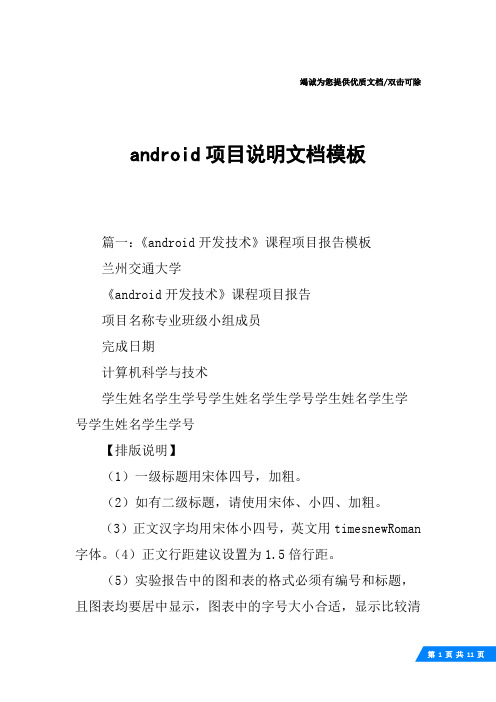
竭诚为您提供优质文档/双击可除android项目说明文档模板篇一:《android开发技术》课程项目报告模板兰州交通大学《android开发技术》课程项目报告项目名称专业班级小组成员完成日期计算机科学与技术学生姓名学生学号学生姓名学生学号学生姓名学生学号学生姓名学生学号【排版说明】(1)一级标题用宋体四号,加粗。
(2)如有二级标题,请使用宋体、小四、加粗。
(3)正文汉字均用宋体小四号,英文用timesnewRoman 字体。
(4)正文行距建议设置为1.5倍行距。
(5)实验报告中的图和表的格式必须有编号和标题,且图表均要居中显示,图表中的字号大小合适,显示比较清晰。
如下所示(图的标题在下方、表的标题在上方):图1xxxxxxx图表1xxxxxxx表【附加说明】(1)报告必须按照本模板的标题来写,具体内容可以根据自己的设计情况如实填写;(2)报告内容的总体排版要求整洁美观;(3)报告按要求命名:项目名称_姓名_班级.doc,例如:音乐播放器_张三_计算机1203班.doc;(4)最终提交的内容包括报告和能够正确运行的完整源代码,源代码为压缩文件,命名规范和报告命名一致;(5)需要提交的材料有纸质报告、报告电子档和项目源代码,材料全部提交给班长,材料提交的截止时间为20xx 年7月9日,逾期按0分记。
1.项目背景1.1项目描述1.2开发环境2.需求分析2.1功能需求2.2性能需求3.总体设计3.1设计思路3.2系统模块划分4.详细设计4.1界面设计4.2算法设计4.3某模块设计4.运行结果5.总结和展望附录(部分源代码)篇二:安卓项目说明文档天女散花效果项目说明一、项目概述在android实现应用屏幕一定时间间隔下,随机出现多片花朵的效果,并同时播放天女散花音乐。
二、项目功能模块图功能模块图(一)三、关键实现技术:1)自定义View自定义view主要是处理界面需要动态处理的情况,自定义view主要继承与android.view.View类下面是自定view的实例publicclassflowersViewextendsView{/***构造器*/publicflowersView(contextcontext,attributesetattrs, intdefstyle){super(context,attrs,defstyle);publicflowersView(contextcontext,attributesetattrs) {super(context,attrs);}@overridepublicvoidondraw(canvascanvas){super.ondraw(canvas);功能模块图(二)}}2)加载图片到内存在这个小应用中,会重复的出现多个花朵的图片,为节省内存,直接在应用开始时,直接将图片转化成内存的对象,在其后页面渲染时,直接用内存的对象下面是加载图片到内存的实例//花图片bitmapbitmap_flower=null;/***加载天女散花的花图片到内存中*publicvoidloadFlowerimage(){Resourcesr=this.getcontext().getResources(); bitmap_flower=((bitmapdrawable)r.getdrawable(R.drawable.flower)).getbitmap(); }3)动态绘制窗体内容动态绘制窗体内容分两块a.动态生成五个花朵//花的位置privatecoordinate[]flowers=newcoordinate[5]; //屏幕的高度和宽度intview_height=0;intview_width=0;/***设置当前窗体的实际高度和宽度*/publicvoidsetView(intheight,intwidth){view_height=height-100;view_width=width-50;/***随机的生成花朵的位置**/publicvoidaddRandomFlower(){flowers[0]=newcoordinate(Rng.nextint(view_width),Rng.nextint(view _height));flowers[1]=newcoordinate(Rng.nextint(view_width),Rng.nextint(view _height));flowers[2]=newcoordinate(Rng.nextint(view_width),Rng.nextint(view _height));flowers[3]=newcoordinate(Rng.nextint(view_width),Rng.nextint(view_height));flowers[4]=newcoordinate(Rng.nextint(view_width),Rng.nextint(view _height));}b.根据花朵的位置重新的渲染窗体for(intx=0;xcanvas.drawbitmap(bitmap_flower,((float)flowers[x]. x),((float)flowers[x].y),mpaint);}4)背景音乐的添加threadrunt=newthreadrun();threadthread=newthread(t);thread.start();privateclassthreadrunimplementsRunnable{publicvoidrun(){system.out.println("mp3------------"+"运行");mediaplayermmediaplayer=newmediaplayer();system.out.println("mp3------------"+"运行1");try{mmediaplayer.setdatasource("/sdcard/text.mp3");mmed iaplayer.prepare();mmediaplayer.start();}catch(ioexceptione){}三、小组成员分工范美君:搜集资料,协助大家做好项目使其正常运行王佳欣:和其他小组成员做好项目后,主要负责ppt的制作李梅:和小组成员一起做好项目,主要负责word安卓项目说明付艳艳:和大家一起做项目,主要负责演讲篇三:android项目设计说明书android——淘宝app开发班级:软件工程133姓名:钱程邹章鹏指导老师:陆培军日期:20xx.6项目设计说明书一、小组成员构成钱程邹章鹏二、任务分工1.任务需求分析:邹章鹏从淘宝网站获取数据,重新构建开发个性化的淘宝购物app软件,要求实现:1.按关键字查询产品2.查询产品详情3.收藏需要关注的产品4.查看收藏产品清单2.程序设计:钱程对需求分析结果进一步分析,构思整体程序设计思路及结构3.代码编写:钱程Volley框架sqllite数据库json数据的传输和解析等等4.程序测试:邹章鹏对程序运行结果进行检测和改进三、项目完成思路1.确定任务需求:对任务需求进行分析,明确实验目标2.确定项目开发工具(1)eclipse+androidsdk+adt或androidstudio(app开发平台)(2)chrome(网页分析工具)(3)/(json查看工具)(4)Regexbuddy(正则表达式调式工具)或json组件,可采用json或fastjson(5)httpclient(获取html数据)(6)sqlite(存放收藏产品数据)3.模块分析(1)主界面模块:该模块主要用于商品搜索(2)商品列表模块:该模块主要用于搜索后商品的显示,包括商品名称、价格和销量(3)商品详情模块:该模块主要显示搜索商品的详细信息,以及提供购买,收藏和收藏夹功能。
android课程设计需求规格说明书
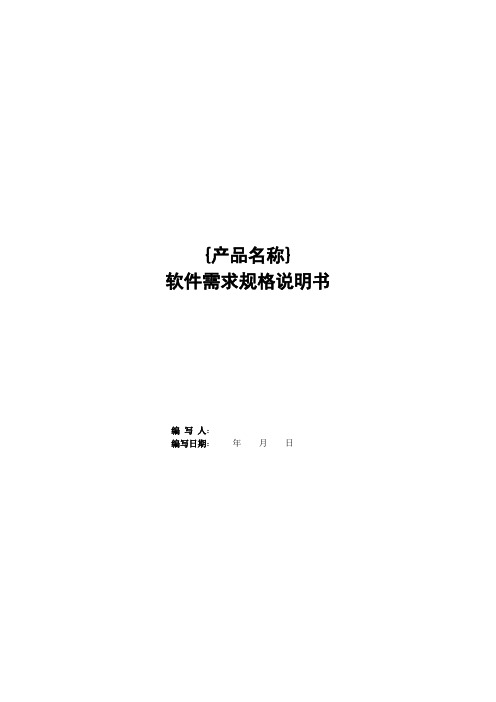
{产品名称} 软件需求规格说明书编写人:编写日期:年月日目录1.产品描述 (3)1.1.编写目的 (3)1.2.产品名称 (3)1.3.名词定义(可选) ..................................... 错误!未定义书签。
2.产品需求概述 (3)2.1.功能简介 (3)2.2.运行环境 (3)2.3.条件与限制(可选) ................................... 错误!未定义书签。
3.功能需求 (3)3.1.功能划分(可选) (3)3.2.功能1 ................................................ 错误!未定义书签。
3.3.功能N ................................................ 错误!未定义书签。
3.4.不支持的功能 (6)4.数据描述 (6)5.性能需求(可选) (7)6.运行需求(可选) (7)6.1.用户界面 (7)6.2.硬件接口 (8)6.3.软件接口 (8)6.4.通信接口 (9)7.其它需求(可选) (9)8.特殊需求(可选) (9)9.不确定的问题(可选) (9)10.编写人员及编写日期 (9)11.附录 (9)11.1.引用文件........................................... 错误!未定义书签。
11.2.参考资料........................................... 错误!未定义书签。
1.产品描述1.1.编写目的该产品适用于高铁乘务人员,方便对司机、行车、站点等信息的管理、保存和同步。
1.2.产品名称广州乘务通2.产品需求概述2.1.功能简介进入手杖首页,历史手杖列表增加手帐:录入手帐基本信息,基本信息录入框(需要对本地字典缓存),所有信息都需要保持到本地数据库,接入wifi自动同步到后台;基本信息保存后,弹出线路(后台线路定义)以及上下行组合选择;出发点、到达点(需要后台数据)基本信息:出勤信息、退勤信息不能修改,当天基本信息可以修改,其他只读;站点信息:2.2.运行环境1.硬件环境:硬盘空间要10M以上内存需要20M以上2.软件环境:系统要求Android 2.2以上数据库sqllite。
Android开发说明文档

Android开发说明文档Android开发说明文档一、开发环境的搭建过程:第一步安装JDK,并在环境变量中配置相应的参数。
第二步安装开发工具,常用的开发工具有两种,一种是eclipse开发工具开发时需要导入ADT插件,一种是motodevstudio开发时不需要任何插件。
第三步安装sdk(android开发环境),并在环境变量中配置相应的参数。
第四步测试环境是否搭建好,以此用命令javac、android –h进行测试,如果命令窗口中出现相应的说明,则证明开发环境搭建成功。
二、实现手机拍照功能:1.UI界面设计UI界面总共有两个,一个是初始化界面,一个是拍照界面。
初始化界面设计,如下图所示;拍照界面设计,在此界面中,设计了两个按钮,一个是拍照按钮,一个是对焦按钮,拍照按钮用于进行对区域范围景色的拍摄,对焦按钮是对所在视野区域焦距进行调节,拍摄窗口是横向显示方式,拍摄暂停画面是花色的;2.功能实现当点击拍照按钮进入拍照界面,拍照界面显示当前的视野,然后点击对焦按钮进行焦距调整,然后点击拍照按钮进行拍照,当出现花色时证明拍照完成,拍照完成的图片保存在sd卡的根目录下。
三、实现百度地图获取地址信息:1.获取百度api的key在用百度账号进入,设置自己的key值,将key值添加到自己程序里的publicstaticfinal String strKey="iDneBU6NBrm9wyLxdOODPTM5";这段代码中。
2.UI界面设计在此界面中用LinearLayout布局管理器,在此界面中设置六个编辑框用于获取当前地址所在信息,具体如下图所示。
3.功能实现当我们带着手机时,走到哪一个地方时,该程序就会在相应的编辑框显现当前地址信息,分别显示的信息是所在市,所在街道,精度,纬度。
Android项目需求文档(Word最新版)
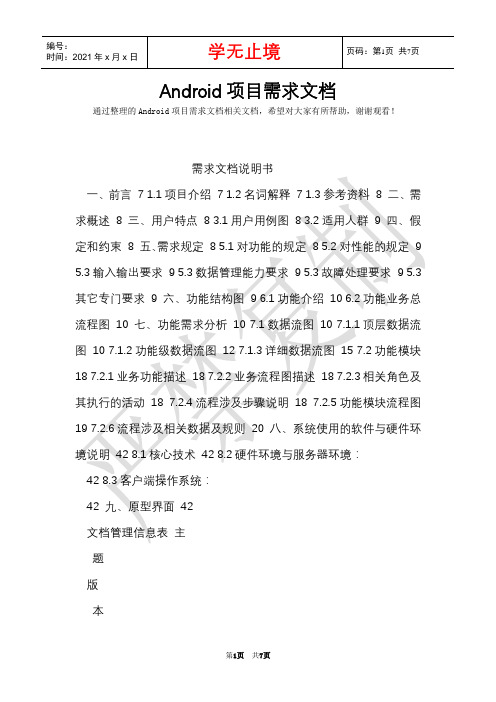
Android项目需求文档通过整理的Android项目需求文档相关文档,希望对大家有所帮助,谢谢观看!需求文档说明书一、前言7 1.1项目介绍7 1.2名词解释7 1.3参考资料8 二、需求概述8 三、用户特点8 3.1用户用例图8 3.2适用人群9 四、假定和约束8 五、需求规定8 5.1对功能的规定8 5.2对性能的规定9 5.3输入输出要求9 5.3数据管理能力要求9 5.3故障处理要求9 5.3其它专门要求9 六、功能结构图9 6.1功能介绍10 6.2功能业务总流程图10 七、功能需求分析10 7.1数据流图10 7.1.1顶层数据流图10 7.1.2功能级数据流图12 7.1.3详细数据流图15 7.2功能模块18 7.2.1业务功能描述18 7.2.2业务流程图描述18 7.2.3相关角色及其执行的活动18 7.2.4流程涉及步骤说明18 7.2.5功能模块流程图19 7.2.6流程涉及相关数据及规则20 八、系统使用的软件与硬件环境说明42 8.1核心技术42 8.2硬件环境与服务器环境:42 8.3客户端操作系统:42 九、原型界面42文档管理信息表主题版本内容规定了项目业务处理过程和用户要求等信息。
关键字业务流程参考文档无提交时间创建人审批人生效日期文档修改记录表修改人修改时间修改内容一、前言1.1项目介绍项目名称:目的:缩写词:开发周期:1.2名词解释列出本文件中用到的专门术语的定义和外文首字母组词的原词组。
1.3参考资料列出用得着的参考资料,如:a.本项目的经核准的计划任务书或合同、上级机关的批文;b.属于本项目的其他已发表的文件;本文件中各处引用的文件、资料、包括所要用到的软件开发标准。
列出这些文件资料的标题、文件编号、发表日期和出版单位,说明能够得到这些文件资料的来源。
二、需求概述叙述该项软件开发的意图、应用目标、作用范围以及其他应向读者说明的有关该软件开发的背景材料。
ANDROID项目计划书
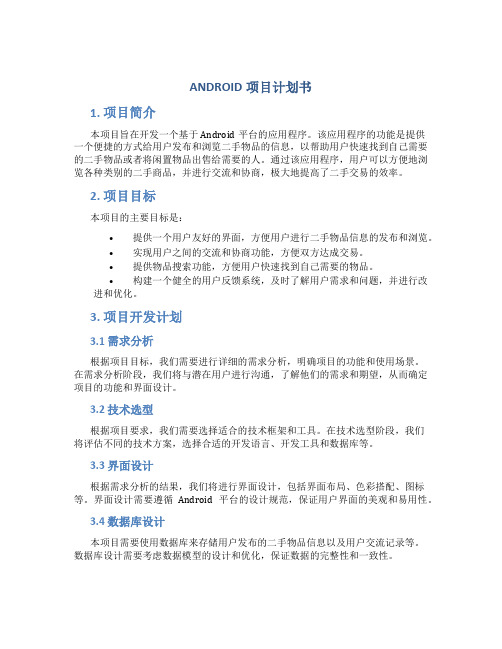
ANDROID项目计划书1. 项目简介本项目旨在开发一个基于Android平台的应用程序。
该应用程序的功能是提供一个便捷的方式给用户发布和浏览二手物品的信息,以帮助用户快速找到自己需要的二手物品或者将闲置物品出售给需要的人。
通过该应用程序,用户可以方便地浏览各种类别的二手商品,并进行交流和协商,极大地提高了二手交易的效率。
2. 项目目标本项目的主要目标是:•提供一个用户友好的界面,方便用户进行二手物品信息的发布和浏览。
•实现用户之间的交流和协商功能,方便双方达成交易。
•提供物品搜索功能,方便用户快速找到自己需要的物品。
•构建一个健全的用户反馈系统,及时了解用户需求和问题,并进行改进和优化。
3. 项目开发计划3.1 需求分析根据项目目标,我们需要进行详细的需求分析,明确项目的功能和使用场景。
在需求分析阶段,我们将与潜在用户进行沟通,了解他们的需求和期望,从而确定项目的功能和界面设计。
3.2 技术选型根据项目要求,我们需要选择适合的技术框架和工具。
在技术选型阶段,我们将评估不同的技术方案,选择合适的开发语言、开发工具和数据库等。
3.3 界面设计根据需求分析的结果,我们将进行界面设计,包括界面布局、色彩搭配、图标等。
界面设计需要遵循Android平台的设计规范,保证用户界面的美观和易用性。
3.4 数据库设计本项目需要使用数据库来存储用户发布的二手物品信息以及用户交流记录等。
数据库设计需要考虑数据模型的设计和优化,保证数据的完整性和一致性。
3.5 功能开发根据需求分析和界面设计,我们将进行功能开发。
开发过程中需要遵循面向对象的设计原则,保证代码的可维护性和扩展性。
功能开发需要经过严格的测试和调试,确保软件的稳定性和可靠性。
3.6 测试和优化在功能开发完成后,我们将进行测试和优化工作。
测试工作包括单元测试、集成测试和用户验收测试等,以发现和修复潜在的问题。
优化工作包括性能优化和用户体验优化等,提高应用程序的运行效率和用户满意度。
【精品文档】android范例大全-范文模板 (22页)
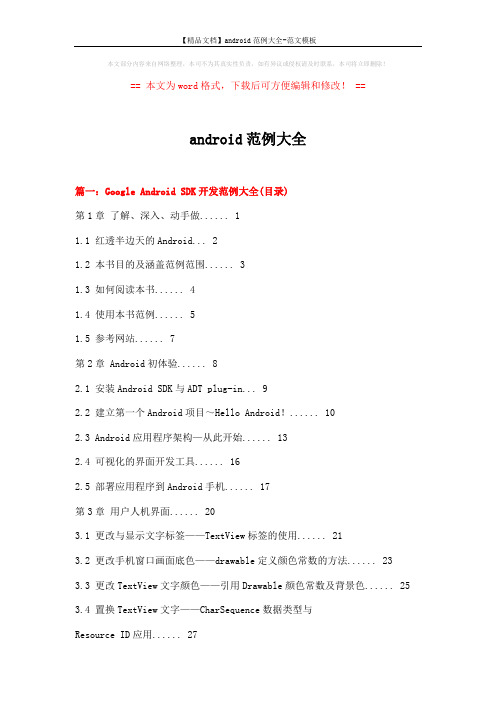
本文部分内容来自网络整理,本司不为其真实性负责,如有异议或侵权请及时联系,本司将立即删除!== 本文为word格式,下载后可方便编辑和修改! ==android范例大全篇一:Google Android SDK开发范例大全(目录)第1章了解、深入、动手做 (1)1.1 红透半边天的Android (2)1.2 本书目的及涵盖范例范围 (3)1.3 如何阅读本书 (4)1.4 使用本书范例 (5)1.5 参考网站 (7)第2章 Android初体验 (8)2.1 安装Android SDK与ADT plug-in (9)2.2 建立第一个Android项目~Hello Android! (10)2.3 Android应用程序架构—从此开始 (13)2.4 可视化的界面开发工具 (16)2.5 部署应用程序到Android手机 (17)第3章用户人机界面 (20)3.1 更改与显示文字标签——TextView标签的使用 (21)3.2 更改手机窗口画面底色——drawable定义颜色常数的方法 (23)3.3 更改TextView文字颜色——引用Drawable颜色常数及背景色 (25)3.4 置换TextView文字——CharSequence数据类型与Resource ID应用 (27)3.5 取得手机屏幕大小——DisplayMetrics取得画面宽高的方法 (29)3.6 样式化的定型对象——Style样式的定义 (31)3.7 简易的按钮事件——Button事件处理 (33)3.8 手机页面的转换——setContentView的应用 (35)3.9 调用另一个Activity——Intent对象的使用 (38)3.10 不同Activity之间的数据传递——Bundle对象的实现 (43)3.11 返回数据到前一个Activity——startActivityForResult方法 (47)3.12 具有交互功能的对话框——AlertDialog窗口 (52)3.13 置换文字颜色的机关——Button与TextView的交互 (54)3.14 控制不同的文字字体——Typeface对象使用 (56)3.15 如iPhone拖动相片特效——Gallery画廊 (59)3.16 自制计算器——多按钮的整合应用 (61)3.17 关于(About)程序信息——Menu功能菜单程序设计 (63)3.18 程序加载中~请稍后——ProgressDialog与线程整合应用 (66)3.19 全屏幕以按钮覆盖——动态产生按钮并最大化 (69)3.20 今晚到哪儿打牙祭?——具选择功能的对话框 (71)3.21 Android变脸——主题(Theme)实现 (74)第4章史上超豪华的手机控件 (77)4.1 EditText与TextView共舞——setOnKeyListener事件 (78)4.2 设计具有背景图的按钮——ImageButton的焦点及事件处理 (79)4.3 给耶诞老人的信息——Toast对象的使用 (83)4.4 我同意条款——CheckBox的isChecked属性 (85)4.5 消费券采购列表——多选项CheckBox的应用 (87)4.6 向左或向右——RadioGroup组与onCheckedChanged事件 (90)4.7 专业相框设计——ImageView的堆栈应用 (93)4.8 自定义下拉菜单模式——Spinner与setDropDownViewResource.. 964.9 动态添加/删除的Spinner菜单——ArrayList与Widget的依赖性......994.10 心爱小宝贝相片集——Gallery与衍生BaseAdapter容器 (103)4.11 快速的搜索手机文件引擎——Java I/O的应用 (106)4.12 按钮也能随点击变换——ImageButton选择特效 (109)4.13 具自动提示功能的菜单——AutoCompleteTextView与数组 (111)4.14 数字及模拟小时钟设计——AnalogClock与DigitalClock的原理 (113)4.15 动态输入日期与时间——DatePicker与TimePicker应用 (116)4.16 猜猜红心A在那儿——ImageView点击事件与透明度处理 (120)4.17 后台程序运行进度提示——ProgressBar与Handler的整合应用 (124)4.18 动态文字排版——GridView与ArrayAdapter设计 (129)4.19 在Activity里显示列表列表——ListView的布局 (133)4.20 以动态列表配置选项——ListActivity与Menu整合技巧 (136)4.21 查找程序根目录下所有文件——Java I/O与ListActivity的结合 (140)4.22 加载手机磁盘里的图文件——使用decodeFile方法 (144)4.23 动态放大缩小ImageView里的图片——运用Matrix对象来缩放图文件 (146)4.24 动态旋转图片——Bitmap与Matrix旋转ImageView (150)4.25 猜猜我在想什么——RadioButton ID (154)4.26 离开与关闭程序的弹出窗口——对话窗口上的ICON图标 (158)第5章交互式通信服务与手机控制...... 162 5.1 具有正则表达式的TextView——Linkify规则 (163)5.2 ACTION!CALL!拨打电话——Intent.ACTION.CALL的使用 (165)5.3 自制发送短信程序——SmsManager与PendingIntent对象 (168)5.4 自制发送Email程序——Intent在Email上的使用 (174)5.5 自制日历手机数据库——实现SQLiteOpenHelper. 1785.6 手机震动的节奏——Vibrator对象及周期运用 (184)5.7 图文可视化提醒——Toast与LinearLayout View (188)5.8 状态栏的图标与文字提醒——NotificationManager与Notification对象的应用 (190)5.9 搜索手机通讯录自动完成——使用ContentResolver. 1955.10 取得联系人资料——Provider.Contact的使用 (200)5.11 制作有图标的文件资源管理器——自定义Adapter对象 (204)5.12 还原手机默认桌面——重写clearWallpaper方法 (210)5.13 置换手机背景图——Gallery与setWallpaper整合实现 (213)5.14 撷取手机现存桌面——getWallpaper与setImageDrawable.. 2175.15 文件资源管理器再进化——Java I/O修改文件名及删除 (219)5.16 取得目前File与Cache的路径——getCacheDir与getFilesDir. 2285.17 打开/关闭WiFi服务——WifiManager状态判断 (232)5.18 取得SIM卡内的信息——TelephonyManager的应用 (242)5.19 调用拨号按钮——打电话CALL_BUTTON (247)5.20 DPAD按键处理——onKeyDown事件与Layout坐标交互 (249)5.21 任务管理器正在运行的程序——RunningTaskInfo (254)。
安卓校园订餐系统项目说明书

“基于Android的安卓校园订餐系统”项目说明书项目小组成员:曹海洋,吴结元,刘鸿宇,胡伟雄目录1.引言 (3)1.1编写目的 (3)2.项目概述 (3)2.1项目名称 (3)2.2项目目的 (3)2.3项目内容 (4)2.4开发小组成员 (5)3.数据库设计 (5)4.功能概述 (5)4.1基本功能介绍 (5)4.2安卓开发环境介绍 (6)4.3设计思路 (6)4.4用户界面设计 (9)5.市场分析 (14)5.1创意分析 (14)5.2目标市场定位 (14)1.引言1.1编写目的“基于Android的安卓校园订餐系统”是一种在安卓手机平台上,运用java语言编写的,面向在校大学生的安卓软件,它集移动互联网及安卓智能手机于一体,能让用户在第一时间点餐订餐,不用再为吃饭排队慢而烦恼。
随着移动互联时代的发展,安卓市场已经占了半壁江山,可谓前景广阔,人们对手机的运用也是越来越多,而手机用户更是在不断的追求新的功能。
本系统将主要基于Android手机端及web端的实现用户可以实时订餐和与他人分享自己喜欢的美食,为本校大学生的就餐提供帮助。
2.项目概述2.1项目名称基于Android的安卓校园订餐系统2.2项目目的什么是“网上订餐”?总的来说,就是由网站担任用户与餐饮商家之间的“媒介”,通过网络通信来实现点餐功能,方便商家和用户进行交互,用户点餐时只需要在手机上点一下就行了,这里面蕴含了巨大的商机,能够有效的提高商家的营业额,增加收益,基于以上元素,所以提出设计这个安卓校园订餐系统。
2.3项目内容一、该系统主要分为两部分,一个为普通用户部分,亦即前台系统。
另外一个是系统的管理员部分,即后台系统。
网上订餐前台系统部分主要是实现网上选菜、预览、产生订单等功能的系统。
后台实现菜单管理、用户管理、订单处理等功能。
二、本项目将设计出一个网上菜单数据库,其要求简要如下:(1)系统用户由两类组成:管理员和客户。
(2)管理员负责后台管理:①菜单信息的维护(增、删、改),菜单要进行分类管理;②客户信息的维护;③订单的确认和删除。
Android设备开发文档说明书

1) What is Android?It is an open-sourced operating system that is used primarily on mobile devices, such as cell phones and tablets. It is a Linux kernel-based system that’s been equipped with rich components that allows developers to create and run apps that can perform both basic and advanced functions.2) What Is the Google Android SDK?The Google Android SDK is a toolset that developers need in order to write apps on Android enabled devices. It contains a graphical interface that emulates an Android driven handheld environment, allowing them to test and debug their codes.3) What is the Android Architecture?Android Architecture is made up of 4 key components:- Linux Kernel- Libraries- Android Framework- Android Applications4) Describe the Android Framework.The Android Framework is an important aspect of the Android Architecture. Here you can find all the classes and methods that developers would need in order to write applications on the Android environment.5) What is AAPT?AAPT is short for Android Asset Packaging Tool. This tool provides developers with the ability to deal with zip-compatible archives, which includes creating, extracting as well as viewing its contents.6) What is the importance of having an emulator within the Android environment?The emulator lets developers “play” around an interface that acts as if it were an actual mobile device. They can write and test codes, and even debug. Emulators are a safe place for testing codes especially if it is in the early design phase.7) What is the use of an activityCreator?An activityCreator is the first step towards the creation of a new Android project. It is made up of a shell script that will be used to create new file system structure necessary for writing codes within the Android IDE.8 ) Describe Activities.Activities are what you refer to as the window to a user interface. Just as you create windows in order to display output or to ask for an input in the form of dialog boxes, activities play the same role, though it may not always be in the form of a user interface.9) What are Intents?Intents displays notification messages to the user from within the Android enabled device. It can be used to alert the user of a particular state that occurred. Users can be made to respond to intents.10) Differentiate Activities from Services.Activities can be closed, or terminated anytime the user wishes. On the other hand, services are designed to run behind the scenes, and can act independently. Most services run continuously, regardless of whether there are certain or no activities being executed.11) What items are important in every Android project?These are the essential items that are present each time an Android project is created:- AndroidManifest.xml- build.xml- bin/- src/- res/- assets/12) What is the importance of XML-based layouts?The use of XML-based layouts provides a consistent and somewhat standard means of setting GUI definition format. In common practice, layout details are placed in XML files while other items are placed in source files.13) What are containers?Containers, as the name itself implies, holds objects and widgets together, depending on which specific items are needed and in what particular arrangement that is wanted. Containers may hold labels, fields, buttons, or even child containers, as examples.14) What is Orientation?Orientation, which can be set using setOrientation(), dictates if the LinearLayout is represented asa row or as a column. Values are set as either HORIZONTAL or VERTICAL.15) What is the importance of Android in the mobile market?Developers can write and register apps that will specifically run under the Android environment. This means that every mobile device that is Android enabled will be able to support and run these apps. With the growing popularity of Android mobile devices, developers can take advantage of this trend by creating and uploading their apps on the Android Market for distribution to anyone who wants to download it.16) What do you think are some disadvantages of Android?Given that Android is an open-source platform, and the fact that different Android operating systems have been released on different mobile devices, there’s no clear cut policy to how applications can adapt with various OS versions and upgrades. One app that runs on this particular version of Android OS may or may not run on another version. Another disadvantage is that since mobile devices such as phones and tabs come in different sizes and forms, it poses a challenge for developers to create apps that can adjust correctly to the right screen size and other varying features and specs.17) What is adb?Adb is short for Android Debug Bridge. It allows developers the power to execute remote shell commands. Its basic function is to allow and control communication towards and from the emulator port.18) What are the four essential states of an activity?- Active – if the activity is at the foreground- Paused – if the activity is at the background and still visible- Stopped – if the activity is not visible and therefore is hidden or obscured by another activity- Destroyed – when the activity process is killed or completed terminated19) What is ANR?ANR is short for Application Not Responding. This is actually a dialog that appears to the user whenever an application have been unresponsive for a long period of time.20) Which elements can occur only once and must be present?Among the different elements, the and elements must be present and can occur only once. The rest are optional, and can occur as many times as needed.21) How are escape characters used as attribute?Escape characters are preceded by double backslashes. For example, a newline character is created using ‘\\n’22) What is the importance of settings permissions in app development?Permissions allow certain restrictions to be imposed primarily to protect data and code. Without these, codes could be compromised, resulting to defects in functionality.23) What is the function of an intent filter?Because every component needs to indicate which intents they can respond to, intent filters are used to filter out intents that these components are willing to receive. One or more intent filters are possible, depending on the services and activities that is going to make use of it.24) Enumerate the three key loops when monitoring an activity- Entire lifetime – activity happens between onCreate and onDestroy- Visible lifetime – activity happens between onStart and onStop- Foreground lifetime – activity happens between onResume and onPause25) When is the onStop() method invoked?A call to onStop method happens when an activity is no longer visible to the user, either because another activity has taken over or if in front of that activity.26) Is there a case wherein other qualifiers in multiple resources take precedence over locale?Yes, there are actually instances wherein some qualifiers can take precedence over locale. There are two known exceptions, which are the MCC (mobile country code) and MNC (mobile network code) qualifiers.27) What are the different states wherein a process is based?There are 4 possible states:- foreground activity- visible activity- background activity- empty process28) How can the ANR be prevented?One technique that prevents the Android system from concluding a code that has been responsive for a long period of time is to create a child thread. Within the child thread, most of the actual workings of the codes can be placed, so that the main thread runs with minimal periods of unresponsive times.29) What role does Dalvik play in Android development?Dalvik serves as a virtual machine, and it is where every Android application runs. Through Dalvik, a device is able to execute multiple virtual machines efficiently through better memory management.30) What is the AndroidManifest.xml?This file is essential in every application. It is declared in the root directory and contains information about the application that the Android system must know before the codes can be executed.31) What is the proper way of setting up an Android-powered device for app development? The following are steps to be followed prior to actual application development in an Android-powered device:-Declare your application as "debuggable" in your Android Manifest.-Turn on "USB Debugging" on your device.-Set up your system to detect your device.32) Enumerate the steps in creating a bounded service through AIDL.1. create the .aidl file, which defines the programming interface2. implement the interface, which involves extending the inner abstract Stub class as well as implanting its methods.3. expose the interface, which involves implementing the service to the clients.33) What is the importance of Default Resources?When default resources, which contain default strings and files, are not present, an error will occur and the app will not run. Resources are placed in specially named subdirectories under the project res/ directory.34) When dealing with multiple resources, which one takes precedence?Assuming that all of these multiple resources are able to match the configuration of a device, the ‘locale’ qualifier almost always takes the highest precedence over the others.35) When does ANR occur?The ANR dialog is displayed to the user based on two possible conditions. One is when there is no response to an input event within 5 seconds, and the other is when a broadcast receiver is not done executing within 10 seconds.36) What is AIDL?AIDL, or Android Interface Definition Language, handles the interface requirements between a client and a service so both can communicate at the same level through interprocess communication or IPC. This process involves breaking down objects into primitives that Android can understand. This part is required simply because a process cannot access the memory of the other process.37) What data types are supported by AIDL?AIDL has support for the following data types:-string-charSequence-List-Map-all native Java data types like int,long, char and Boolean38) What is a Fragment?A fragment is a part or portion of an activity. It is modular in a sense that you can move around or combine with other fragments in a single activity. Fragments are also reusable.39) What is a visible activity?A visible activity is one that sits behind a foreground dialog. It is actually visible to the user, but not necessarily being in the foreground itself.40) When is the best time to kill a foreground activity?The foreground activity, being the most important among the other states, is only killed or terminated as a last resort, especially if it is already consuming too much memory. When a memory paging state has been reach by a foreground activity, then it is killed so that the user interface can retain its responsiveness to the user.41) Is it possible to use or add a fragment without using a user interface?Yes, it is possible to do that, such as when you want to create a background behavior for a particular activity. You can do this by using add(Fragment,string) method to add a fragment from the activity.42) How do you remove icons and widgets from the main screen of the Android device?To remove an icon or shortcut, press and hold that icon. You then drag it downwards to the lower part of the screen where a remove button appears.43) What are the core components under the Android application architecture?There are 5 key components under the Android application architecture:- services- intent- resource externalization- notifications- content providers44) What composes a typical Android application project?A project under Android development, upon compilation, becomes an .apk file. This apk file format is actually made up of the AndroidManifest.xml file, application code, resource files, and other related files.45) What is a Sticky Intent?A Sticky Intent is a broadcast from sendStickyBroadcast() method such that the intent floats around even after the broadcast, allowing others to collect data from it.46) Do all mobile phones support the latest Android operating system?Some Android-powered phone allows you to upgrade to the higher Android operating system version. However, not all upgrades would allow you to get the latest version. It depends largely on the capability and specs of the phone, whether it can support the newer features available under the latest Android version.47) What is portable wi-fi hotspot?Portable Wi-Fi Hotspot allows you to share your mobile internet connection to other wireless device. For example, using your Android-powered phone as a Wi-Fi Hotspot, you can use your laptop to connect to the Internet using that access point.48) What is an action?In Android development, an action is what the intent sender wants to do or expected to get as a response. Most application functionality is based on the intended action.49) What is the difference between a regular bitmap and a nine-patch image?In general, a Nine-patch image allows resizing that can be used as background or other image size requirements for the target device. The Nine-patch refers to the way you can resize the image: 4 corners that are unscaled, 4 edges that are scaled in 1 axis, and the middle one that can be scaled into both axes.50) What language is supported by Android for application development?The main language supported is Java programming language. Java is the most popular language for app development, which makes it ideal even for new Android developers to quickly learn to create and deploy applications in the Android environment.Guru99 Provides FREE ONLINE TUTORIAL on Various courses likeJava MIS MongoDB BigData CassandraWeb Services SQLite JSP Informatica AccountingSAP Training Python Excel ASP Net HBase ProjectTest Management Business Analyst Ethical Hacking PMP ManagementLive Project SoapUI Photoshop Manual Testing Mobile TestingData Warehouse R Tutorial Tableau DevOps AWSJenkins Agile Testing RPA JUnitSoftware EngineeringSelenium CCNA AngularJS NodeJS PLSQL。
Android项目报告书
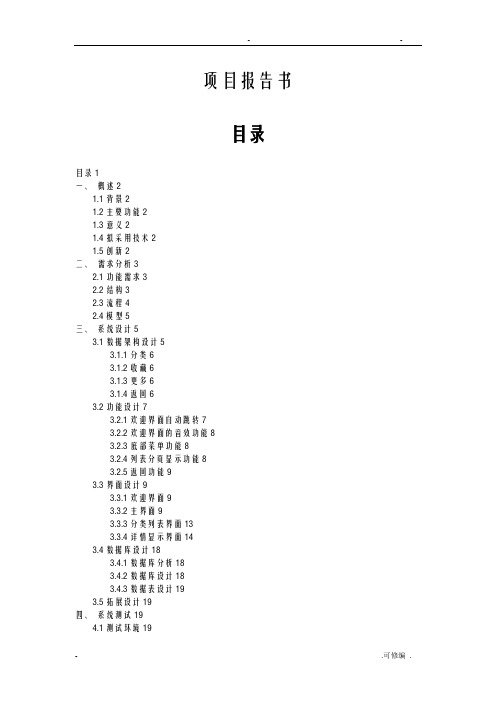
项目报告书目录目录1一、概述21.1背景21.2主要功能21.3意义21.4拟采用技术21.5创新2二、需求分析32.1功能需求32.2结构32.3流程42.4模型5三、系统设计53.1数据架构设计53.1.1分类63.1.2收藏63.1.3更多63.1.4返回63.2功能设计73.2.1欢迎界面自动跳转73.2.2欢迎界面的音效功能83.2.3底部菜单功能83.2.4列表分页显示功能83.2.5返回功能93.3界面设计93.3.1欢迎界面93.3.2主界面93.3.3分类列表界面133.3.4详情显示界面143.4数据库设计183.4.1数据库分析183.4.2数据库设计183.4.3数据表设计193.5拓展设计19四、系统测试194.1测试环境194.2测试过程描述204.2.1单元测试204.2.2集成测试204.2.3功能测试204.3测试用例214.4测试结果21一、概述1.1背景当前,是信息化的时代。
随着人们生活水平是不断提高,信息科技也在发生日新月异的变化,android手机应用程序已经成为了人们生活中的一部分。
就以本项目来说,我们设计的是《新闻阅读器》,给广大爱看新闻的人们带来了方便。
1.2主要功能●欢迎界面●新闻信息的列表分页显示●新闻的详情显示●菜单的切换和跳转1.3意义新闻行业已经不仅仅可以通过电视、报纸等宣传讯息,现在是高科技的时代,网上信息传播的速度要比传统的通讯快,所以我们采用了android手机开发的《新闻阅读器》可以让用户随时随地的了解新闻的最新资讯。
1.4拟采用技术1、本项目是以java为基础、android4.0平台开发的一款手机应用程序2、本项目采用了SAX技术和JSON解析技术,解析XML数据文件3、本项目运用了非常美观的UI设计,给用户耳目一新的效果体验。
4、同时本项目使用了国际化1.5创新1)本项目采用了底部菜单和标题栏配合使用,使用户在体验时操作更加的方便;2)本项目以绿色为主题,UI设计大方、有新意,字体搭配协调;3)本项目采用了国际化设计,体现了人机交互的效果。
Android项目报告书

项目报告书目录目录 (1)一、概述 (2)1.1背景 (2)1.2主要功能 (2)1.3意义 (3)1.4拟采用技术 (3)1.5创新 (3)二、需求分析 (3)2.1功能需求 (3)2.2结构 (4)2.3流程 (4)2.4模型 (4)三、系统设计 (4)3.1数据架构设计 (4)........................................................................... 错误!未定义书签。
........................................................................... 错误!未定义书签。
........................................................................... 错误!未定义书签。
........................................................................... 错误!未定义书签。
3.2功能设计 (5)........................................................................... 错误!未定义书签。
........................................................................... 错误!未定义书签。
........................................................................... 错误!未定义书签。
........................................................................... 错误!未定义书签。
Android项目目录结构模板以及简单说明【简单版】

Android项⽬⽬录结构模板以及简单说明【简单版】版权声明:本⽂为HaiyuKing原创⽂章,转载请注明出处!概述开发Android项⽬的时候,⼀般都是⼀边开发⼀边根据需求创建⽬录(包、module),那么我呢就根据以往的项⽬经验,整理出⼀个⽐较简单的⽬录结构,供以后项⽬开发参考。
注意:这⾥只是项⽬的⽬录结构图,不涉及⾥⾯的代码。
其中部分必须的代码参考《》、《》项⽬组织结构图简单说明appassets⽬录:建议项⽬中需要放到assets⽬录的⽂件都放到这⾥,尽量不放到其他module的assets中(⽐如base、thirslib),这样便于统⼀管理;activity⽬录:BaseActivity和与项⽬业务⽆关的activity(⽐如WelcomeActivity)放到包的根⽬录下,其他与项⽬业务相关的activity放到新建的以业务名称命名的⼦包⽬录下,如果项⽬⽐较简单,那么就统⼀放到normal⽬录下即可。
adapter⽬录:适配器类集合bean⽬录:实体类集合dialog⽬录:BaseDialogFragment放到包的根⽬录下,其他与项⽬业务相关的dialog放到新建的以业务名称命名的⼦包⽬录下,如果项⽬⽐较简单,那么就统⼀放到normal⽬录下即可。
enumtype⽬录:枚举类集合fragment⽬录:BaseFragment放到包的根⽬录下,其他与项⽬业务相关的fragment放到新建的以业务名称命名的⼦包⽬录下,如果项⽬⽐较简单,那么就统⼀放到normal⽬录下即可。
listener⽬录:监听器类集合mvp⽬录:mvp模式的根⽬录mvp/iview⽬录:mvp模式中的Vmvp/model⽬录:mvp模式中的Mmvp/presenter⽬录:mvp模式中的Putils⽬录:常⽤⼯具类集合(注意,区别base中的utils⽬录,这⾥是仅在app中⽤到的⼯具类,不是通⽤⼯具类集合,通⽤⼯具类集合在base/utils⽬录中)views⽬录:⾃定义view集合(注意,区别base中的views⽬录,这⾥是仅在app中⽤到的⾃定义view,不是通⽤⾃定义view集合,通⽤⾃定义view集合在base/views⽬录中)MyApplication.java⽂件:项⽬声明的⾃定义Application类(注意:项⽬中所有需要在⾃定义Application中声明的⽅法,⽐如引⼊第三⽅平台时⼀些配置,都需要写在这⾥,⽽不是base中的BaseApplication或者thirdlib中的ThirdApplication中;)res⽬录:就不需要多说了,需要注意,drawable-hdpi、mdpi、xhdpi、xxhdpi、xxxhdpi⽬录需要⾃⼰创建,新建项⽬后没有的⽬录或者⽂件,可以从这⾥复制过去,当然了,⾃⼰新建⽬录或者⽂件即可。
(完整word版)android实验报告范文模板
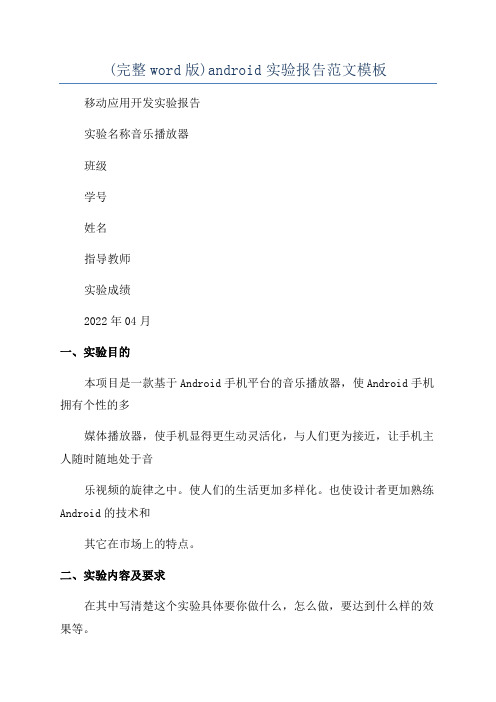
(完整word版)android实验报告范文模板移动应用开发实验报告实验名称音乐播放器班级学号姓名指导教师实验成绩2022年04月一、实验目的本项目是一款基于Android手机平台的音乐播放器,使Android手机拥有个性的多媒体播放器,使手机显得更生动灵活化,与人们更为接近,让手机主人随时随地处于音乐视频的旋律之中。
使人们的生活更加多样化。
也使设计者更加熟练Android的技术和其它在市场上的特点。
二、实验内容及要求在其中写清楚这个实验具体要你做什么,怎么做,要达到什么样的效果等。
本设计实现的主要功能是播放Mp3,Wav多种格式的音乐文件,并且能够控制播放,暂停,停止,,下一首,上一首播放列等基本播放控制功能,界面简明,操作简单。
三、实验方案设计在其中写清楚你的程序的详细设计,用流程图配文字的形式描述。
如果其中涉及到算法,一定要把算法阐述清楚。
3.1.1假设安装了音乐播放器的用户是系统的主要设计对象,其拥有以下操作,启动软件、播放音乐、暂停播放、停止播放、退出软件,其用例图如下图2.1播放器基本用例图3.1.2用例分析2用例名称:启动软件参与者:用户目标:使得用户启动软件并加载手机和d卡上的音频文件到播放列表前置条件:无基本事件流:1.用户启动软件2.播放器将播放列表中的当前的歌曲用例名称:播放参与者:用户目标:使得用户可以播放在播放列表中选中的歌曲前置条件:播放器正在运行基本事件流:1.用户单击“播放”按钮2.播放器将播放列表中的当前的歌曲用例名称:暂停参与者:用户目标:使得用户可以暂停正在播放的歌曲前置条件:歌曲正在播放且未停止和暂停基本事件流:1.用户单击“暂停”按钮2.播放器将暂停当前的歌曲④用例名称:停止参与者:用户目标:使得用户可以停止正在播放的歌曲前置条件:歌曲正在播放或暂停基本事件流:1.用户单击“停止”按钮2.播放器将停止当前播放的歌曲⑤用例名称:推出参与者:用户目标:使得用户退出或者后台播放音乐前置条件:程序在运行基本事件流:1.用户按返回键2.播放器退出或者进入后台播放四、实验测试Step1.启动软件后,软件自动检索手机和d卡的音频文件,并组织显示成列表.Step2.点击列表的歌曲名字。
2019-android项目开发范例-推荐word版(23页)

2019-android项⽬开发范例-推荐word版(23页)本⽂部分内容来⾃⽹络整理,本司不为其真实性负责,如有异议或侵权请及时联系,本司将⽴即删除!== 本⽂为word格式,下载后可⽅便编辑和修改! ==android项⽬开发范例篇⼀:Android应⽤程序开发完整训练:从零起步通过23个动⼿实战案例精通App开发从零起步,24⼩时内通过23个动⼿实战案例,循序渐进的对Android商业级别的应⽤程序开发要点各个击破,依托于在多年的Android(6款完整的硬件产品和超过20款应⽤软件)开发和企业级培训经验(超过150期的次Android的企业内训和公开课),旨在在实务的基础之上帮助你完成任何复杂程序的⾼质量Android应⽤程序开发,让Android开发跟上想象的速度。
最后,通过ActivityManagerService揭秘Android应⽤程序⼀切⾏为背后的核⼼根源,让你从此开发应⽤程序居⾼零下、举重若轻。
课程要点:1,抽取Android应⽤开发中⽤到的最精华的Java技术加以剖析;2,从零起步构建Android开发环境和编写并彻底剖析第⼀个Android程序;3,彻底剖析不同Activity之间所有的交互模式;4,根据商业化场景彻底剖析Android的⽣命周期及其使⽤的最佳时间;5,使⽤JUnit测试Android业务代码;6,掌握Android基本和核⼼的UI开发技术;7,”Android商业化⾼级UI实战”是根据过去20多款商业级别Android应⽤程序开发尤其是类似CRM系统中最经典、最经常使⽤的技术抽取⽽成,掌握之后基本上不会在遇到UI⽅⾯的难点;8,细致剖析并实战Android性能测试,找出性能瓶颈,并进⾏代码优化,分享代码优化的最佳实践;9,对数据的处理时Android绝⼤多数应⽤程序的核⼼,尤其是对CRM系统⽽⾔,这⼀天,我们会对Android中的本地数据处理⽅式及其商业使⽤场景进⾏彻底剖析和实战;10,从SharedPreferences到内部⽂件系统,从SDCard操作到SQLite数据库,从XML和JSON的解析于⽣成到数据共享统⼀接⼝ContentProvider,对Android本地的数据处理⽅式进⾏地毯式轰炸;11,通讯录的操作的原理、流程和场景等进⾏了情景再现性的代码实战;12,通过Android⼿机卫⼠商业级别的代码案例实战Android中BroadcastReceiver和Service;13,根据过去20多款程序的商业实战总结出了能够解决基于HTTP协议的任意⽂件类型、任意⼤⼩⽂件的⽹络上传和下载,Android⽹络开发从此⼀劳永逸;14,实战WiFi数据交换;15,尤其是额外提到异步http框架,具备很强的商业价值;16,Android横竖屏切换的经典场景、⽣命周期和解决⽅案;17,实战构建多语⾔国际化的Android应⽤程序;18,如何编译APK来提⾼应⽤的安全性;19,如何反编译Android应⽤20,通过Android中WebView的特性洞悉Android中JavaScript与Java相互沟通的密码,追寻浏览器和HTML5开发的架构和技术实现根源;21,使⽤NDK等技术利⽤C/C++的⾼效性来提⾼应⽤程序的性能;22,实现Android中以Looper、Handler、Message、MessageQueue为核⼼的线程间通信⽅式;23,实战并剖析AsyncTask框架实现的源代码,并提出对AsyncTask缺陷的解决⽅案;24,最后,揭秘Android应⽤程序⼀切⾏为背后的核⼼根源:ActivityManagerService 课程⽬标:1,从零起步24⼩时内掌握Android应⽤程序开发2,通晓Android的架构哲学和⼒量来源以及实现技术;3,能够开发出任意类型、任意复杂程度的安全、⾼效的应⽤程序;4,根据过去的20多款Android商业应⽤软件的实践,提供弥⾜珍贵的源代码,上完课程即相当于完成了Android应⽤项⽬80%左右的开发,所有的开发难点⼀扫⽽光;课程要求:对Android有强烈兴趣,能够读懂基本的C#或Java语法;王家林⽼师Android架构师、⾼级⼯程师、咨询顾问、培训专家;通晓Android、HTML5、Hadoop,迷恋英语播⾳和健美;致⼒于Android、HTML5、Hadoop的软、硬、云整合的⼀站式解决⽅案;国内最早(201X年)从事于Android系统移植、软硬整合、框架修改、应⽤程序软件开发以及Android系统测试和应⽤软件测试的技术专家和技术创业⼈员之⼀。
ANDROID项目文档
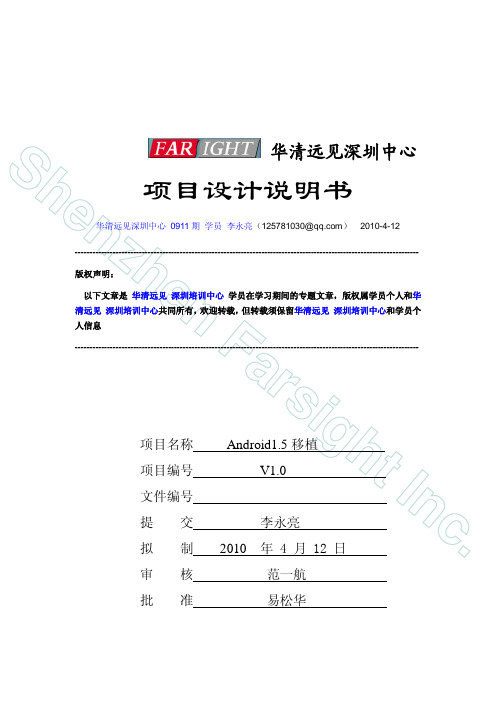
S h e nz h e nF a r s i gh t In c .0911 125781030@ 2010-4-12 ---------------------------------------------------------------------------------------------------------------------- ----------------------------------------------------------------------------------------------------------------------Android1.5V1.02010 4 12S h e n z h e n F ar s i g h t In c . 1 125781030@ Android -- 1Android...........................................................................................................................................1 .......................................................................................................................................1 ....................................................................................................................................2 .......................................................................................................................................2 1A NDROID ..................................................................................................................................2 1.1 Android.. (2)1.2 Android .............................................................................................................2 2 D EV K IT 8000.. (2)3. A NDROID (3)4. A NDROID (3)5. L INUX (3)5.1 (3)5.2 (4)5.3 Linux OSS (4)5.4 Linux ALSA (4)6. P LATFORM (5)7. B MP ...............................................................................................................................5 . (7)1. L INUX (7)1.1OSS.................................................................................................................................7 1.2ALSA...............................................................................................................................8 2.C AMERA ........................................................................................................................10 2.1V4L...............................................................................................................................10 2.2V4L2.............................................................................................................................14 3.A NDROID A UDIO S YSTEM ............................................................................................................19 4.A NDROID V IDEO OUTPUT S YSTEM : O VERLAY S YSTEM .........................................................................20 5. A NDROID V IDEO OUPUT S YSTEM : C AMERA S YSTEM ...........................................................................21 ........................................................................................................................23 1.A NDROID A UDIO S YSTEM ..............................................................................23 2.A NDROID C AMERA P REVIEW USB C AMERA ...............................................27 3. A NDROID JFFS 2 .........................................................................................................31 . (32) (33) (33)S h e nz h e n F a r s i g h t I n c .Android1.5 Omap3530 Android1.5 Omap3530 GPRS Wifi Camera GPS Android Android OSS ALSA video4linux video4linux2 bmp peg HALS h e n z h enF ar s i g h t In c.Google Android1.5(cupcake) Omap3530 GPRS Wifi Camera GPScupcake1.5r2, ubuntu9.10, Linux2.6.29Omap3530 GSM wifi GPS1 Android Android Android Android Android 1.1 Android Android Linux Google 2007 11 5 Google Open Handset Alliance software stack Linux Java Google Android Google gPhoneAndroid Linux kernel GNU Linux GNU/Linux Android 1.2 Android Android Android Android HTC ASUS Android 2 DevKit8000DevKit8000 TI OMAP3530 CPU OMAP3530 600MHz ARM Cortex™-A8 412MHz DSP DevKit8000 S-VIDEOS h e n z h e n F a r si gh t In c . USB OTG USB HOST SD/MMC SPI IIC JTAG Camera TFT HDMI3. AndroidLibrary VirtualMachineBionic Android libc Android Webkit Webkit Apple Safari Surface flinger 2D 3D Android (Toolchain) Google Bionic LibcAndroid OpenCORE OpenCORE 7 PVPlayer PVAuthor Codec PacketVideo Multimedia Framework(PVMF) Operating System Compatibility Library(OSCL) Common OpenMAXAndroid skia OpenGL/ES skia Linux Cairo Linux Cairo, skia 2005 Skia Google 2007 Skia GL Skia Google ChromeAndroid SQLite ContentResolver ColumnAndroid Java Dalvik Dalvik Virtual Machine Dalvik Register Based JavaDalvik instance, Android Dalvik Dalvik Java Bytecode .dex 4. Android Android HAL Android framework Linux kernel Linux kernel kernel independent Android HAL HAL stub .so proxy Android runtime HAL stub operations callback 5. Linux 5.11 48kHz2.S h e n z h e n F a r si gh t I n c .5.21. PCM PCM( ) PCM2. IIS IIS3. AC97 AC97 IIS AC975.3 Linux OSS1. OSSOSS mixer dspDSP D/A2. mixerregister_sound_mixer()3. dspdsp register_sound_dsp()DMA DMAOSS 5.4 Linux ALSA 1. ALSAOSS ALSA ALSA SMP (alsa-lib) OSS API OSS2. cardcard card3. PCMPCM PCM PCM PCM PCM PCM4.(switch) (slider) control mixer mixer control API5. ALSAALSA alsa-libS h e n z h en F a r s i g h t I n c .6. PlatformLinux 2.6 :Platform_device Platform_driver Linux , Platform_devicePlatform_driverLinux platform driver device driver ( driver_register ) platform platform device ( )Platform platform_device platfrom_driver Platform : platform_device platform_device platform_driver platform_driver7. Bmp BMP BblP BMP lbit 4bit 8bit 24bit BMPBMP Windows Windows BMPBMP BMP BMP1 1 424Dh="BM" Windows BMP2 2-3 4690 0000 00009046h=369343 4-5 04 6-7 4600 0000 00000046h=70 35 =705 8-96 10-11 8000 0000 00000080h=1287 12-13 9000 0000 00000090h=1448 14 1 0100 0001h=19 15 1 4 16 8 256 16 64K 24 16M 32 4096M 1000 0010h=1610 16-17 0 1 RLE 8 8 RLE 2 RLE 4 4 RLE 3 Bitfields RLE + T408 r5b6g5 0300 0000 00000003h=3S h e n z h e n F a r s i g h t I n c .11 18-19 4 0090 0000 00009000h=80×90×2h=36864 12 20-21 / A00F 0000 0000 0FA0h=4000 13 22-23 / A00F 0000 0000 0FA0h=400014 24-25 015 26-27 016 28-35 RGB 1111 ( 0)24- RGB00F8 0000 E007 0000 1F00 0000 0000 000000FB 0000 FB00h=1111100000000000E007 0000 07E0h=00000111111000001F00 0000 001Fh=00000000000111110000 0000 016 5 6 5 r g b r g b 8 4 8 rgb 24 BMP17)17-S h e n z h e n F a r si gh t I n c .1. Linux2.1 DSP PCM IIS AC97 AD DA 2.11.1 OSSOSS mixer dsp mixer /dev/mixer mixerDSP /dev/dsp /dev/sound/dsp OSS /dev/dsp/ D/A A/D1. dspdsp(1) /dev/dsp(2)(3)(4)S h e n z h e n F a r si gh t I n c .(5) /dev/dsp 2. mixer /dev/mixer8 16 0~100dsp mixer Linux OSS 2.22.2 Linux OSS 1.2 ALSAOSS ALSA(Advanced Linux Sound Architecture) ALSA SMP (alsa-lib) OSS API OSSS he nz h enF ar si gh t In c.2.3 ALSA2.3 ALSA alsa-driver alsa-lib alsa alsa-libs asoundlib.h, libasound.so; Alsa-driver ; alsa app , alsa device driver alsa driver .2.4 ALSAOSS ALSA alsa-lib alsa-lib jack 2.4 ALSA ALSA OSSS he nz h enF ar si gh t In c.2. Camera2.1 V4L1. video4linuxVideo4linux V4L), linux Linux /dev/video0 2.Video4linux 1 23 4 : a.b.5 6•typedef struct v4l_struct •{• int fd;• struct video_capability capability; • struct video_channel channel[4]; • struct video_picture picture; • struct video_window window; • struct video_capture capture; • struct video_buffer buffer; • struct video_mmap mmap; • struct video_mbuf mbuf; • unsigned char *map; • int frame;• int framestat[2]; •}vd;3.Video4linux 1 video_capability• ••name[32] //•maxwidth maxheight minwidth minheight •Channels //•type // capture VID_TYPE_CAPTURES he nz h enF ar si gh t In c.•2 video_picture• •brightness 0~65535 •hue •colour •contrast •whiteness •depth // 24•palette //VIDEO_PALETTE_RGB243 video_channel Channel //name tunersType VIDEO_TYPE_TV | IDEO_TYPE_CAMERA Norm4 video_window // capture area xx windows .y x windows .width The width of the image capture. height The height of the image capture.chromakey A host order RGB32 value for the chroma key. flags Additional capture flags.clips A list of clipping rectangles. (Set only)clipcount The number of clipping rectangles. (Set only) 5 video_mbuf mmap size //Frames //Offsets //6 video_buffer buffervoid *baseBase physical address of the buffer int heightHeight of the frame buffer int widthWidth of the frame buffer int depthDepth of the frame bufferint bytesperlineNumber of bytes of memory between the start of two adjacent lines 7 video_mmap // mmap 4. 1S he nz h enF ar si gh t In c.Open ”/dev/video0” vdàfd);close ”/dev/video0” vdàfd); 2 video_capabilityioctl(vd->fd, VIDIOCGCAP, &(vd->capability)) vd->capability eg. 3 video_pictureioctl(vd->fd, VIDIOCGPICT, &(vd->picture))4 video_picture VIDIOCSPICTEg.•vd->picture.colour = 65535;•if(ioctl(vd->fd, VIDIOCSPICT, &(vd->picture)) < 0) •{•perror("VIDIOCSPICT"); •return -1; •}5 channel • vd->capability•for (i = 0; i < vd->capability.channels; i++) • {• vd->channel[i].channel = i;• if (ioctl(vd->fd, VIDIOCGCHAN, &(vd->channel[i])) < 0) • {• perror("v4l_get_channel:"); • return -1; • } • }mmap•mmap( ) read() write• A B A B A B•1 picture2 video_mbuf buffer ioctl(vd->fd, VIDIOCGMBUF, &(vd->mbuf))3 video_mmap• Eg. vd->mmap.format = VIDEO_PALETTE_RGB24• vd->framestat[0] = vd->framestat[1] = 0; vd->frame = 0; 4 mmap video_mbufS he nz h enF ar si gh t In c.•void* mmap ( void * addr , size_t len , int prot , int flags , int fd , off_t offset )•len // offset •Prot // PROT_READ , PROT_WRITE , PROT_EXEC•flags // MAP_SHARED MAP_PRIVATE // MAP_ FIXED addr // 0 •Mmap( )•if((vd->map = (unsigned char*)mmap(0, vd->mbuf.size, PROT_READ|PROT_WRITE, MAP_SHARED, vd->fd, 0)) < 0) •{•perror("v4l_mmap mmap:"); •return -1; •}5 Mmap VIDIOCMCAPTUREioctl(vd->fd, VIDIOCMCAPTURE, &(vd->mmap)) ; • • VIDIOCSYNC 6 VIDIOCSYNC•if(ioctl(vd->fd, VIDIOCSYNC, &frame) < 0) •{•perror("v4l_sync:VIDIOCSYNC"); •return -1; •}VIDIOCMCAPTURE •frame****•video_bmuf bmuf.frames = 2; • •int frame; //•int framestat[2]; // | • vd->map + vd->mbuf.offsets[vd->frame] • munmap •munmap(vd->map, vd->mbuf.size)• read•int read ( ); • •int len ;S he nz h enF ar si gh t In c.2.2 V4L2. video4linux2Video4linux2 V4L2), V4L2 V4L 2.6 V4L2ioctl1. int fd=open(”/dev/video0 ,O_RDWR);2. capability ,VIDIOC_QUERYCAP,struct v4l2_capability3. VIDIOC_S_INPUT,struct v4l2_input4. PAL NTSCVIDIOC_S_STD,VIDIOC_S_FMT,struct v4l2_std_id,struct v4l2_format 5. 5 struct v4l2_requestbuffers6. mmap7. .VIDIOC_QBUF,struct v4l2_buffer 8. VIDIOC_STREAMON9. VIDIOC_DQBUF 10. , VIDIOC_QBUF 11. VIDIOC_STREAMOFF 12. close(fd);( /usr/include/linux/videodev2.h)struct v4l2_requestbuffers reqbufs;// struct v4l2_capability cap;// struct v4l2_input input; //struct v4l2_standard std;// PAL NTSC struct v4l2_format fmt;// struct v4l2_buffer buf;//v4l2_std_id stdid;// V4L2_STD_PAL_B struct v4l2_queryctrl query;// struct v4l2_control control;//V4L2 open1. //2.int cameraFd;S he nz h enF ar si gh t In c.3. cameraFd = open(“/dev/video0 , O_RDWR | O_NONBLOCK, 0);4. //5.//cameraFd = open(”/dev/video0 , O_RDWR, 0);DQBUFFLinux ioctl I/Oextern int ioctl (int __fd , unsigned long int __request , …) __THROW ;__fd ID open cameraFd__requestV4L21. VIDIOC_REQBUFS2. VIDIOC_QUERYBUF VIDIOC_REQBUFS3. VIDIOC_QUERYCAP4. VIDIOC_ENUM_FMT5. VIDIOC_S_FMT6. VIDIOC_G_FMT7. VIDIOC_TRY_FMT8. VIDIOC_CROPCAP9. VIDIOC_S_CROP 10. VIDIOC_G_CROP 11. VIDIOC_QBUF 12. VIDIOC_DQBUF 13. VIDIOC_STREAMON 14. VIDIOC_STREAMOFF15.VIDIOC_QUERYSTD PAL NTSCIOPAL 720X576 NTSC 720X480 VIDIOC_QUERYSTD1. v4l2_std_id std;2. do {3. ret = ioctl(fd, VIDIOC_QUERYSTD, &std);4. } while (ret == -1 && errno == EAGAIN);5. switch (std) {6.case V4L2_STD_NTSC:S he nz h enF ar si gh t In c.7. //……8. case V4L2_STD_PAL: 9. //…… 10.}1. struct v4l2_format fmt;2. memset ( &fmt, 0, sizeof (fmt) );3. fmt.type = V4L2_BUF_TYPE_VIDEO_CAPTURE;4. fmt.fmt.pix.width = 720;5. fmt.fmt.pix.height = 576;6. fmt.fmt.pix.pixelformat = V4L2_PIX_FMT_YUYV;7. fmt.fmt.pix.field = V4L2_FIELD_INTERLACED;8. if (ioctl(fd, VIDIOC_S_FMT, &fmt) == -1) {9. return -1;10. } v4l2_format1. struct v4l2_format2. {3. enum v4l2_buf_type type;// V4L2_BUF_TYPE_VIDEO_CAPTURE4. union5. {6. struct v4l2_pix_format pix;7. struct v4l2_window win;8. struct v4l2_vbi_format vbi;9. __u8 raw_data[200]; 10. } fmt; 11. }; 12.13. struct v4l2_pix_format 14. {15. __u32 width; // 16 16. __u32 height; // 16 17. __u32 pixelformat;// YUV422,RGB18. enum v4l2_field field;19. __u32 bytesperline; 20. __u32 sizeimage; 21. enum v4l2_colorspace colorspace; 22. __u32 priv; 23.};S he nz h enF ar si gh t In c.1. struct v4l2_requestbuffers req;2. if (ioctl(fd, VIDIOC_REQBUFS, &req) == -1) {3. return -1;4.}v4l2_requestbuffers1. struct v4l2_requestbuffers2. {3. __u32 count; //4. enum v4l2_buf_type type;//V4L2_BUF_TYPE_VIDEO_CAPTURE5. enum v4l2_memory memory; // V4L2_MEMORY_MMAP V4L2_MEMORY_USERPT R6. __u32 reserved[2];7. };VIDIOC_REQBUFS req.count VIDIOC_QUERYBUF mmap1. typedef struct VideoBuffer {2. void *start;3. size_t length;4. } VideoBuffer;5.6.7. VideoBuffer* buffers = calloc( req.count, sizeof (*buffers));8. struct v4l2_buffer buf; 9.10. for (numBufs = 0; numBufs < req.count; numBufs++) {11. memset( &buf, 0, sizeof (buf) );12. buf.type = V4L2_BUF_TYPE_VIDEO_CAPTURE; 13. buf.memory = V4L2_MEMORY_MMAP; 14. buf.index = numBufs; 15. // 16.17. if (ioctl(fd, VIDIOC_QUERYBUF, &buf) == -1) { 18. return -1; 19. } 20.21. buffers[numBufs].length = buf.length; 22.23. //24.buffers[numBufs].start = mmap(NULL, buf.length,S he nz h enF ar si gh t In c.25. PROT_READ | PROT_WRITE, 26. MAP_SHARED,27. fd, buf.m.offset); 28.29. if (buffers[numBufs].start == MAP_FAILED) { 30.return -1; 31. } 32.33. //34. if (ioctl(fd, VIDIOC_QBUF, &buf) == -1) {35. return -1; 36. } 37.}v4l2read write read writemmapv4l2_requestbuffers memory V4L2_MEMORY_USERPTRV4L2 req.count FIFO ioctl ,VIDIOC_DQBUF VIDIOC_QBUF1. struct v4l2_buffer buf;2. memset(&buf,0,sizeof (buf));3. buf.type=V4L2_BUF_TYPE_VIDEO_CAPTURE;4. buf.memory=V4L2_MEMORY_MMAP;5. buf.index=0;6.7. //8. if (ioctl(cameraFd, VIDIOC_DQBUF, &buf) == -1) 9. {10. return -1; 11. } 12.S he nz h enF ar si gh t In c.13. //………… 14. //15. if (ioctl(cameraFd, VIDIOC_QBUF, &buf) == -1) { 16. return -1; 17.}closeclose (cameraFd )munmap3. Android Audio SystemAudio System Android Android Audio PCM PCMAudio1) media Audio 2) AudioFlinger Audio 3) Audio4) Audio JNI Java Audio Track Recorder Android Audio 2.5S he nz h enF ar si gh t In c.2.5 Android AudioAudioAudio libmedia.so AudioAudioFlinger libmeida libaudiofilnger.so libmedia libaudioflinger.soAudio JNI Java JNI libmediaAudio AudioFlinger AudioAndroid Audio AudioPCMAndroid Audio Audio 2-12-1 AndroidAudio AudioAudioJava android.media.AudioSystemandroid.medie.AudioTrack android.media.AudioRecorderAudioSystemAudioTrackAudioRecorderAudioFlinger IAudioFlinger IAudioTrackIAudioRecorder AudioHardwareInterface AudioStreamOutAudioStreamIn4. Android Video output System: Overlay SystemOverlay Android OverLayAndroid Overlay Java JNIa. libui Overlayb. SurfaceFlinger Overlayc. OverlayAndroid Overlay 2.6 Android Overlay Overlay Overlay Overlay CameraS he nz h enF ar si gh t In c.2.6 Android Overlay5. Android Video ouput System: Camera System2.6 Android CameraA ndroid CameraS he nz h enF ar si gh t In c.Camera Java Cameraa. libui Camerab. CameraSeriesc. CameraCamera API libui 3 API Camera JNI Java Android Java CameraAndroid Camera 2.6CameraCameraService Camera libui Camera.h Camera Camera libui IPC CameraCamera Camera Icamera CameraS he nz h enF ar si gh t In c.1. Android AudioSystem1. ( GIT // AudioSystemDEVICE_OUT_EARPIECEa. platform_external_alsa-lib:git clonegit:///android-on-freerunner/platform_external_alsa-lib.git external alsa-lib b. platform_hardware_alsa_soundgit clonegit:///android-on-freerunner/platform_hardware_alsa_sound.git hardware libaudio-alsa c. platform_external_alsa-utils (git clonegit:///android-on-freerunner/platform_external_alsa-utils.git external alsa-utils DEVICE_OUT_EARPIECEgit clone git:///platform/external/alsa-lib.git git clone git:///platform/external/alsa-utils.git git clone git:///platform/hardware/alsa_sound.gitS he nz h enF ar si gh t In c.2. system/core/init/device.c /dev/snd:1. ......2. } else if (!strncmp(uevent->subsystem, "mtd", 3)) {3. base = "/dev/mtd/";4. mkdir(base, 0755);5. } else if (!strncmp(uevent->subsystem, "sound", 5)) {6. base = "/dev/snd/";7. mkdir(base, 0755);3. system/core/init/devices.c, :1. static struct perms_ devperms[] = {2. ...3. { "/dev/snd/", 0664, AID_SYSTEM, AID_AUDIO, 1 },4. ...5.4. build/target/board/generic/BoardConfig.mk1. 1 # config.mk2. 2 #3. 3 # Product-specific compile-time definitions.4. 4 #5. 56. 6 # The generic product target doesn't have any hardware-specific pieces.7. 7 TARGET_NO_BOOTLOADER := true8. 8 TARGET_NO_KERNEL := true9. 9 TARGET_NO_RADIOIMAGE := true 10. 10 #HAVE_HTC_AUDIO_DRIVER := true 11. 11 BOARD_USES_ALSA_AUDIO := true 12. 12 BUILD_WITH_ALSA_UTILS := true 13. 13 #BOARD_USES_GENERIC_AUDIO := true 14. 14 BOARD_USES_GENERIC_AUDIO := false5. hardware/libaudio-alsa/Android.mk1. 1 # hardware/libaudio-alsa/Android.mk2. 2 #3. 3 # Copyright 2008 Wind River SystemsS he nz h enF ar si gh t In c.4. 4 #5. 56. 6 ifeq ($(strip $(BOARD_USES_ALSA_AUDIO)),true )7. 78. 8 LOCAL_PATH := $(call my-dir) 9. 910. 10 include $(CLEAR_VARS) 11. 1112. 12 LOCAL_ARM_MODE := arm13. 13 LOCAL_CFLAGS := -D_POSIX_SOURCE14. 14 # LOCAL_WHOLE_STATIC_LIBRARIES := libasound 15. 15 16. 16 LOCAL_C_INCLUDES += external/alsa-lib/include 17. 17 18. 18 LOCAL_SRC_FILES := AudioHardwareALSA.cpp 19. 1920. 20 LOCAL_MODULE := libaudio 21. 22 LOCAL_STATIC_LIBRARIES += libaudiointerface \22. 23 # libasound 23. 2424. 25 LOCAL_SHARED_LIBRARIES := \ 25. 26 libcutils \ 26. 27 libutils \ 27. 28 libmedia \28. 29 libhardware_legacy \ 29. 30 libdl \ 30. 31 libc \ 31. 32 libasound 32. 3333. 34 include $(BUILD_SHARED_LIBRARY) 34. 35 35. 36 endif6. a). build/envsetup.sh b). choosecombo7. make clean ( ) 8. make -j2S he nz h enF ar si gh t In c.9. .10. asound.conf1. ctl.AndroidOut {2. type hw3. card 04. }5. ctl.AndroidIn {6. type hw7. card 08. }9. pcm.AndroidPlayback { 10. type hw 11. card 0 12. device 013. }14. pcm.AndroidRecord { 15. type hw 16. card 0 17. device 011. init.rc Audio owner , init.rc)chown root audio /dev/snd/controlC0 chown root audio /dev/snd/pcmC0D0c chown root audio /dev/snd/pcmC0D0p chown root audio /dev/snd/timer chmod 0666 /dev/snd/controlC0 chmod 0666 audio /dev/snd/pcmC0D0c chmod 0666 audio /dev/snd/pcmC0D0p chmod 0666 audio /dev/snd/timerS he nz h enF ar si gh t In c.2. Android Camera USB Camera1. hardware/ cameramkdir hardware/camera2. frameworks/base/camera/libcameraservice/ CameraHardwareStub.cppCameraHardwareStub.h hardware/cameracp frameworks/base/camera/libcameraservice/CameraHardwareStub.* hardware/camera 3. CameraHardwareStub.h, CameraHardwareStub.cppCameraHardwareStub CameraHardware;4. frameworks/base/camera/libcameraservice/ CameraSeriver.cpp482 PIXEL_FORMA T_YCbCr_420_SP PIXEL_FORMAT_RGB_565;5. hardware/camera UsbCamer.h6. #ifndef _USBCAMERA_H7. #define _USBCAMERA_H8. #define NB_BUFFER 49. #define DEFAULT_FRAME_RATE 3010. #define VIDEO_PALETTE_JPEG 21 11. #define DEFAULT_DEVICE "/dev/video0" 12. #define MAX_JPEG_FILE 12813. #define POSIX_FNAME_MAX 25614. #define BMP_FILE_HEADER_LEN 5415. #define BMP_FILE_WIDTH_FIELD_OFFSET 0x12 16. #define BMP_FILE_HEIGHT_FIELD_OFFSET 0x1617. #define VIDEO_MAXFRAME 2 18. #include <utils/MemoryBase.h> 19. #include <utils/MemoryHeapBase.h> 20. #include <linux/videodev.h> 21.22. namespace android {23. typedef struct _Usb_Camera_struct 24. {25. int fd;26. struct video_capability capability; 27. struct video_picture picture; 28. struct video_window videowin; 29. struct video_mmap mmap; 30. struct video_mbuf mbuf;31. unsigned char *map; // 32. int frame_current;33. int frame_using[VIDEO_MAXFRAME]; // 34. }UsbCamera_device; 35. typedef struct { 36. long filesize;S he nz h enF ar si gh t In c.37. char reserved[2]; 38. long headersize; 39. long infoSize; 40. long width; 41. long depth; 42. short biPlanes;43. short bits;44. long biCompression; 45. long biSizeImage; 46. long biXPelsPerMeter; 47. long biYPelsPerMeter; 48. long biClrUsed; 49. long biClrImportant; 50. } BMPHEAD; 51.52. class UsbCamera { 53. public :54. UsbCamera();55. ~UsbCamera();56. int Open(char *dev); 57. void Close (); 58. int Init ();59. int getNextFrameAsRGB565(unsigned char *buf); 60. void GrabRawFrame(char *previewBuffer);//jpeg: 640X48061. 62. 63. private : 64.65. UsbCamera_device vd; 66. int jpeg_size; 67.68. int Get_capability( ); 69. int Get_picture( ); 70. int GetDepth(int format); 71. int Get_jpeg_size( );72. int get_bmpfile_info(const char *rawbmpbuf,73. unsigned char **bmpdata, 74. int *width, 75. int *height);76. void get_RGB565(char *buf, unsigned short *fb16, int xMax, int yMax); 77. int Grab_init( ); 78. int Read_pic( );79. int Set_picture(int br,int hue,int col,int cont,int white); 80. int Usb_Camera_init( );S he n z h enF a r s i gh t In c .81. void convertframe(unsigned char *dst, size_t jpegsize) ;82. int jpeg2bmp(char *bmp_buf, char *jpg_buf, int jpegsize);83. int partition_bmp( char *filename, char *bmpbuf,int w, int h);84.85. int bmp2fb16_rgb565(unsigned char *bmpdata,86. unsigned short *fb16, 87. int xres,88. int yres,89. int bytes_per_line);90. int Device_init( );91. };92. }; // namespace android93. #endif6. hardware/camera UsbCamer .cppvideo for linux7. hardware/camera CameraHardwareStub.h,CameraHardwareStub.cpp CameraHardware.h, CameraHardware.cpp 8. CameraHardware.h a.108. #ifdef USB_CAMERA109. UsbCamera *mUsbcamera; 110. #else111. FakeCamera *mFakeCamera; 112. #endif 9. CameraHardware.cppa. int CameraHardware::previewThread()view plaincopy to clipboardprint? 190. uint8_t *frame = ((uint8_t *)base ) + offset;191. #ifdef USB_CAMERA192. mUsbcamera->getNextFrameAsRGB565(frame);193. #else194. fakeCamera->getNextFrameAsYuv422(frame);195. #endifb. status_t CameraHardware::startPreview241. #ifdef USB_CAMERAS h e nz h enF a r s i gh t I n c .242. LOGE("Start USB Camera");243. mUsbcamera->Init();244. #endif245. mPreviewThread = new PreviewThread(this );246. return NO_ERROR; c. void CameraHardware::stopPreview() 261. if (mPreviewThread != 0) { 262. 263. #ifdef USB_CAMERA 264. LOGE("tianfeng: close usb camera"); 265. //usb_camera_close(); 266. mUsbcamera->Close(); 267. #endif 268. } 10. system/core/init/devices.c, :1. static struct perms_ devperms[] = {2. ...3. { "/dev/video0", 0666, AID_CAMERA, AID_CAMERA, 0 },4. ...5.11.a). build/envsetup.shb). choosecombo12. m ake –j213.14. a. arm linux kernel make menuconfigb. Multimedia device-> Video for linux video4linuxc. usb support-> (*) support for usb usb cameraS h e n z h e nF a r si g h t I n c .d. make uImage3. Android jffs21. jffs2 mkfs.jffs2 ubntun9.10 usr/bin2. Android init.rc “# # mount yaffs2 mtd@userdata /data nosuid nodev mount yaffs2 mtd@userdata /data nosuid nodev3. cd Android jffs2 mkfs.jffs2 -r filesystem -o filesystem.jffs2 -e 0x40004. arch/arm/mach-omap2board-omap3beagle.c1. static struct mtd_partition omap3beagle_nand_partitions[] = {2. /* All the partition sizes are listed in terms of NAND block size */3. {4. .name = "X-Loader",5. .offset = 0,6. .size = 4 * NAND_BLOCK_SIZE,7. .mask_flags = MTD_WRITEABLE, /* force read-only */ 8. },9. {10. .name = "U-Boot", 11. .offset = MTDPART_OFS_APPEND, /* Offset = 0x80000 */12. .size = 15 * NAND_BLOCK_SIZE,13. .mask_flags = MTD_WRITEABLE, /* force read-only */ 14. },15. {16. .name = "U-Boot Env",17. .offset = MTDPART_OFS_APPEND, /* Offset = 0x260000 */ 18. .size = 1 * NAND_BLOCK_SIZE,19. },20. {21. .name = "Kernel", 22. .offset = MTDPART_OFS_APPEND, /* Offset = 0x280000 */23. .size = 32 * NAND_BLOCK_SIZE,24. },25. {26. .name = "File System",27. .offset = MTDPART_OFS_APPEND, /* Offset = 0x680000 */28. .size = 80*(8*NAND_BLOCK_SIZE),S he n z h e n F a r s i g h t I n c .29. },30. {31. .name = "userdata",32. .offset = MTDPART_OFS_APPEND, /* offset = 0x5680000 */33. .size = 32*(8*NAND_BLOCK_SIZE),34. }, 35. };5. jffs26.b. tftpc.tftp 0x80300000 uImagenand unlocknand ecc swnand erase 280000 300000nand write.i 80300000 280000 3000007.a) jffs2 tftpb) XXfilesystem.jffs2 16 YY0x33e0838tftp 0x81000000 XX.jffs2nand unlocknand ecc swnand erase 680000 0x5000000nand write.jffs2 81000000 680000 YYnand erase 5680000 0x20000007setenv bootargs mem=128M console=ttyS2,115200n8 init=/init root=31:04 rootfstype=jffs2 video=omapfb:mode:4.3inch_LCDsetenv bootcmd nand read.i 80300000 280000 250000 \; bootm 80300000saveenvS h e n z h enF a r s i g h t I n c .Omap3530USB CameraUSB Camera Camera.(1) Android(2) Linux(3) /zhanghuiliang/archive/2008/10/20/3110758.aspx(4) /a/linux/201001/8382.html(5) /xiaoyufen/blog/item/41108ad43a73a400a18bb7b0.html。
Android应用说明书格式

Android应用作品说明书(供参考模板)一、作品简介主要包括界面、功能板块、主要功能、人机交互设计、稳定/安全性。
要求提供5幅截图和简单说明。
二、作品创意主要包括创意来源和开发理念描述。
三、作品价值主要包括实用价值、主要创新点、技术、产品及服务的新颖性、先进性和独特性。
四、市场分析主要包括市场前景、市场定位、竞争分析、用户吸引力分析。
1.市场前景:项目的产品方案、管理、及市场投入产出预期进行分析和进行前瞻性预测。
2.市场定位:项目的技术、产品、服务水平在行业中所处的地位、提供的产品或服务预计所占的市场份额目标。
3.竞争分析:确定本项目是否有竞争者?如无,何时出现潜在竞争者?如有,相对与竞争者的市场位置,列出在目标市场中的1-3个主要竞争者;分析竞争者的优势和劣势。
4.用户吸引力分析:产品和服务对顾客的主要吸引点,如何增加产品和服务对顾客的吸引力?五、商业模式主要包括推广模式、盈利模式。
1.推广模式:何种方式进行推广,保证达到推广效果的措施。
2.盈利模式:项目总体和每个阶段的盈利模式及渠道,从哪里获得收入,获得收入的形式有哪几种?六、作品定位主要包括适用对象、应用场景、应用现状。
1.适用对象:确定目标顾客群,想要把产品和服务卖给谁?满足其何种需求。
为客户带来什么价值?2.应用场景:指一个应用被使用的时候,用户“最可能的”所处场景。
场景包括时间、空间、设备支持、社交及用户情绪等多个方面。
3.应用现状:目前项目所处发展阶段。
可分为研发、测试、发售、市场拓展等四个阶段。
七、财务分析主要包括已有资金、资金需求及使用计划、成本与利润估算。
1.已有资金:目前吸纳投资额及其来源,股东自有资金,亲属、朋友私人拆借、银行贷款、政府相关部门小额贷款。
各类资金所占的投资总额比例。
2.资金需求:提供未来三年的资金需求,包括融资金额及时间。
使用计划包括工资、场地、交通、研发、设备、产品推广费用等。
3.成本与利润估算:提供融资后未来三年的盈亏平衡表、资产负债表、损益表、现金流量表。
Android项目实训模板
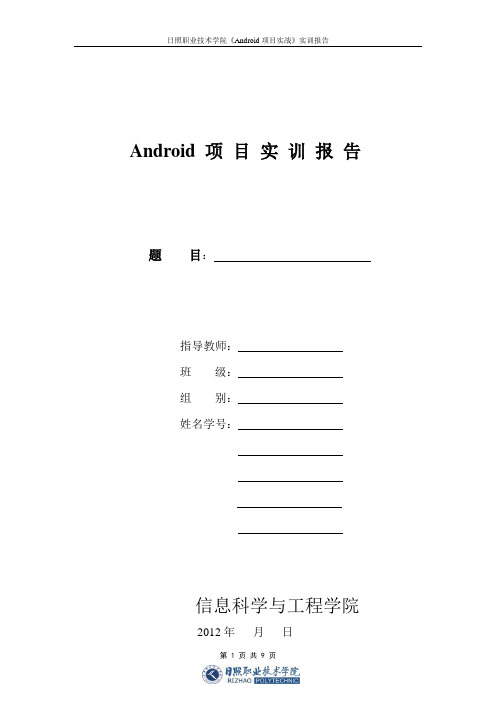
Android 项目实训报告题目:指导教师:班级:组别:姓名学号:信息科学与工程学院2012年月日目录1.序言 (3)1.1选题背景 (3)1.2选题目的及意义 (3)1.3 选题完成情况 (4)2.小组项目需求分析 (4)2.1项目功能需求 (4)2.2项目性能需求 (4)2.3其他需求 (6)3.小组项目概要设计 (7)3.1系统功能结构设计 (7)3.2系统整体架构设计 (7)4.小组项目详细设计 (7)4.1模块1描述 (7)4.1.1 功能描述 (7)4.1.2 性能描述 (7)4.1.5关键函数设计 (8)5.个人项目需求分析 (4)2.1项目功能需求 (4)2.2项目性能需求 (4)2.3其他需求 (6)6.个人项目概要设计 (7)3.1系统功能结构设计 (7)3.2系统整体架构设计 (7)7.个人项目详细设计 (7)4.1模块1描述 (7)4.1.1 功能描述 (7)4.1.2 性能描述 (7)4.1.5关键函数设计 (8)8.实训总结 (8)5.1技术总结.......................................................................................... 错误!未定义书签。
5.2思想总结.......................................................................................... 错误!未定义书签。
1.序言1.1选题背景当今社会的生活节奏越来越快,人们对手机的要求也越来越高,由于手机市场发展迅速,使得手机操作系统也出现了不同各类,现在的市场上主要有三个手机操作系统,Windows mobile,symbian,以及谷歌的Android操作系统,其中占有开放源代码优势的Android系统有最大的发展前景。
那么能否在手机上拥有自己编写的个性音乐播放器呢?能的,谷歌Android系统就能做到。
- 1、下载文档前请自行甄别文档内容的完整性,平台不提供额外的编辑、内容补充、找答案等附加服务。
- 2、"仅部分预览"的文档,不可在线预览部分如存在完整性等问题,可反馈申请退款(可完整预览的文档不适用该条件!)。
- 3、如文档侵犯您的权益,请联系客服反馈,我们会尽快为您处理(人工客服工作时间:9:00-18:30)。
竭诚为您提供优质文档/双击可除android项目说明文档模板篇一:《android开发技术》课程项目报告模板兰州交通大学《android开发技术》课程项目报告项目名称专业班级小组成员完成日期计算机科学与技术学生姓名学生学号学生姓名学生学号学生姓名学生学号学生姓名学生学号【排版说明】(1)一级标题用宋体四号,加粗。
(2)如有二级标题,请使用宋体、小四、加粗。
(3)正文汉字均用宋体小四号,英文用timesnewRoman 字体。
(4)正文行距建议设置为1.5倍行距。
(5)实验报告中的图和表的格式必须有编号和标题,且图表均要居中显示,图表中的字号大小合适,显示比较清晰。
如下所示(图的标题在下方、表的标题在上方):图1xxxxxxx图表1xxxxxxx表【附加说明】(1)报告必须按照本模板的标题来写,具体内容可以根据自己的设计情况如实填写;(2)报告内容的总体排版要求整洁美观;(3)报告按要求命名:项目名称_姓名_班级.doc,例如:音乐播放器_张三_计算机1203班.doc;(4)最终提交的内容包括报告和能够正确运行的完整源代码,源代码为压缩文件,命名规范和报告命名一致;(5)需要提交的材料有纸质报告、报告电子档和项目源代码,材料全部提交给班长,材料提交的截止时间为20xx 年7月9日,逾期按0分记。
1.项目背景1.1项目描述1.2开发环境2.需求分析2.1功能需求2.2性能需求3.总体设计3.1设计思路3.2系统模块划分4.详细设计4.1界面设计4.2算法设计4.3某模块设计4.运行结果5.总结和展望附录(部分源代码)篇二:安卓项目说明文档天女散花效果项目说明一、项目概述在android实现应用屏幕一定时间间隔下,随机出现多片花朵的效果,并同时播放天女散花音乐。
二、项目功能模块图功能模块图(一)三、关键实现技术:1)自定义View自定义view主要是处理界面需要动态处理的情况,自定义view主要继承与android.view.View类下面是自定view的实例publicclassflowersViewextendsView{/***构造器*/publicflowersView(contextcontext,attributesetattrs, intdefstyle){super(context,attrs,defstyle);publicflowersView(contextcontext,attributesetattrs) {super(context,attrs);}@overridepublicvoidondraw(canvascanvas){super.ondraw(canvas);功能模块图(二)}}2)加载图片到内存在这个小应用中,会重复的出现多个花朵的图片,为节省内存,直接在应用开始时,直接将图片转化成内存的对象,在其后页面渲染时,直接用内存的对象下面是加载图片到内存的实例//花图片bitmapbitmap_flower=null;/***加载天女散花的花图片到内存中*publicvoidloadFlowerimage(){Resourcesr=this.getcontext().getResources(); bitmap_flower=((bitmapdrawable)r.getdrawable(R.drawable.flower)).getbitmap(); }3)动态绘制窗体内容动态绘制窗体内容分两块a.动态生成五个花朵//花的位置privatecoordinate[]flowers=newcoordinate[5]; //屏幕的高度和宽度intview_height=0;intview_width=0;/***设置当前窗体的实际高度和宽度*/publicvoidsetView(intheight,intwidth){view_height=height-100;view_width=width-50;/***随机的生成花朵的位置**/publicvoidaddRandomFlower(){flowers[0]=newcoordinate(Rng.nextint(view_width),Rng.nextint(view _height));flowers[1]=newcoordinate(Rng.nextint(view_width),Rng.nextint(view _height));flowers[2]=newcoordinate(Rng.nextint(view_width),Rng.nextint(view _height));flowers[3]=newcoordinate(Rng.nextint(view_width),Rng.nextint(view_height));flowers[4]=newcoordinate(Rng.nextint(view_width),Rng.nextint(view _height));}b.根据花朵的位置重新的渲染窗体for(intx=0;xcanvas.drawbitmap(bitmap_flower,((float)flowers[x]. x),((float)flowers[x].y),mpaint);}4)背景音乐的添加threadrunt=newthreadrun();threadthread=newthread(t);thread.start();privateclassthreadrunimplementsRunnable{publicvoidrun(){system.out.println("mp3------------"+"运行");mediaplayermmediaplayer=newmediaplayer();system.out.println("mp3------------"+"运行1");try{mmediaplayer.setdatasource("/sdcard/text.mp3");mmed iaplayer.prepare();mmediaplayer.start();}catch(ioexceptione){}三、小组成员分工范美君:搜集资料,协助大家做好项目使其正常运行王佳欣:和其他小组成员做好项目后,主要负责ppt的制作李梅:和小组成员一起做好项目,主要负责word安卓项目说明付艳艳:和大家一起做项目,主要负责演讲篇三:android项目设计说明书android——淘宝app开发班级:软件工程133姓名:钱程邹章鹏指导老师:陆培军日期:20xx.6项目设计说明书一、小组成员构成钱程邹章鹏二、任务分工1.任务需求分析:邹章鹏从淘宝网站获取数据,重新构建开发个性化的淘宝购物app软件,要求实现:1.按关键字查询产品2.查询产品详情3.收藏需要关注的产品4.查看收藏产品清单2.程序设计:钱程对需求分析结果进一步分析,构思整体程序设计思路及结构3.代码编写:钱程Volley框架sqllite数据库json数据的传输和解析等等4.程序测试:邹章鹏对程序运行结果进行检测和改进三、项目完成思路1.确定任务需求:对任务需求进行分析,明确实验目标2.确定项目开发工具(1)eclipse+androidsdk+adt或androidstudio(app开发平台)(2)chrome(网页分析工具)(3)/(json查看工具)(4)Regexbuddy(正则表达式调式工具)或json组件,可采用json或fastjson(5)httpclient(获取html数据)(6)sqlite(存放收藏产品数据)3.模块分析(1)主界面模块:该模块主要用于商品搜索(2)商品列表模块:该模块主要用于搜索后商品的显示,包括商品名称、价格和销量(3)商品详情模块:该模块主要显示搜索商品的详细信息,以及提供购买,收藏和收藏夹功能。
(4)收藏夹模块:该模块主要显示收藏过的商品四、项目设计1.总体思路:(1)页面设计(2)连接淘宝获取数据(3)解析数据(4)页面显示(5)数据库的操作2.主要功能:界面1:上方为edittext,用户可以此输入搜索词,下面方采用列表显示搜索得到的产品列表,app首次启动时,此时没有用户输入查询词,默认显示“皮鞋”或其它自设定词的查询产品列表。
产品列表中至少需要显示产品图片、产品标题、产品价格、产品销量,可以显示更多关于产品的信息,但至少需显示上述4项。
列表以行显示,一行显示一个产品,用户单击某一行,则app跳转显示到界面2界面2:显示从界面跳转过来的产品的详细信息,至少需要包括(图片,标题,价格,折扣价,销量,卖家昵称,其它信息可自行添加),在界面的最下方显示“购买”、"收藏"、"查看"按钮,用户单击"购买"按钮,跳转到淘宝对应的产品详情页,如果用户单击"收藏",将该产品信息收藏(或以设计一张数据表保存收藏的产品),如果该产品未被收藏过,则显示弹出信息"收藏成功",如果产品已被收藏过,则显示"收藏失败,该产品已被收藏,请单击查看按钮"。
界面3:用户单击查看按钮后的显示已收藏产品界面,显示该用户所收藏的所有产品,以列表形式显示界面4:单击购买按钮,自动跳转至淘宝app宝贝详情页,并实现立即购买功能。
五、数据库设计建表语句:createtableifnotexistsgoods(_idi ntegerprimarykeyautoincrement,titletextnotnull,pric etextnotnull,sellcounttextnotnull,imgurltextnotnull,item_idtextnotnull)六、app界面1111。
